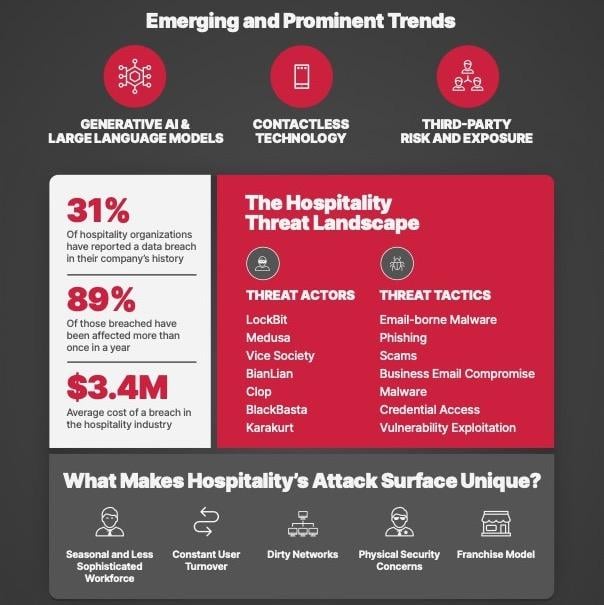In an increasingly digitized world, the rising tide of data breaches poses an ever-present threat to individuals and organizations alike. As cybercriminals become more sophisticated, the landscape of data breaches is constantly evolving, unveiling new trends that require our vigilance. Understanding these emerging patterns is essential for effective prevention and response. From ransomware attacks targeting critical infrastructure to the exploitation of remote work vulnerabilities, the dangers are manifold. In this landscape, staying informed is not just prudent; it’s imperative for safeguarding our sensitive information and maintaining trust in the digital age.
Table of contents
ToggleUnderstanding the Landscape of Data Breaches
As we delve into the digital realm, the frequency and sophistication of data breaches continue to evolve, impacting businesses and individuals alike. Understanding the current landscape is crucial to developing robust defensive strategies.
The first trend to note is the rise of ransomware attacks. These incidents not only encrypt sensitive data but also threaten to leak it if demands are not met. Organizations must adopt a proactive approach, including regular backups and employee training to mitigate risks.
Next, the emergence of insider threats cannot be overlooked. Whether intentional or accidental, employees’ actions can lead to significant vulnerabilities. Companies should implement strict access controls and actively monitor user activity to safeguard sensitive information.
Phishing attacks continue to be a popular method for cybercriminals. By disguising malicious communications, they trick users into revealing personal information. To combat this, organizations should invest in regular cybersecurity training and simulate phishing attempts to educate employees on recognizing suspicious behavior.
The use of Internet of Things (IoT) devices is also growing, but these often unsecure devices can create new entry points for attackers. Ensuring that all connected devices are properly secured and regularly updated is essential to strengthening overall security posture.
Finally, the increasing prevalence of cloud breaches signals the need for heightened awareness around data storage solutions. Organizations must prioritize securing their cloud environments through encryption, multi-factor authentication, and continuous monitoring to help protect sensitive information.
By staying informed about these emerging trends and implementing necessary safeguards, businesses can enhance their resilience against the ever-evolving threat landscape of data breaches.
The Shift Towards Targeted Attacks
The landscape of data breaches has evolved dramatically over the past few years, with organizations facing numerous challenges that require constant vigilance. Understanding these shifts is crucial for businesses and individuals alike. From sophisticated attack techniques to the rise of personal data exploitation, the emerging trends in cybersecurity can significantly impact how we protect our sensitive information.
One of the most alarming trends is the shift towards targeted attacks. Cybercriminals are increasingly focusing on specific individuals or companies rather than casting a wide net with indiscriminate phishing schemes. These targeted attacks, often referred to as social engineering, exploit personal relationships and detailed research to create custom-tailored strategies that can bypass traditional security measures.
Key elements of these targeted attacks include:
- Spear Phishing: Unlike regular phishing attempts that target large groups, spear phishing aims at specific individuals within an organization, often imitating trusted contacts.
- Baiting: This tactic involves enticing victims into malicious activities, such as downloading infected files or clicking on dangerous links.
- Business Email Compromise (BEC): Cybercriminals impersonate executives or key personnel to trick employees into transferring funds or sensitive data.
Moreover, the growing accessibility of malicious tools has made it easier for almost anyone to become a cybercriminal. With dark web marketplaces teeming with hacking kits and stolen data, the barrier to entry for prospective attackers is lower than ever. As a result, even smaller organizations are not immune, leading to a wider array of entities being targeted.
Understanding these trends is essential for devising effective strategies to mitigate the risks associated with data breaches. By investing in robust cybersecurity training, implementing multi-factor authentication, and adopting a proactive approach towards incident response, businesses can significantly strengthen their defenses against these emerging threats.
Ransomware and Its Evolving Tactics
The landscape of data breaches is continuously shifting, influenced by technology advancements and alterations in cybercriminal tactics. Understanding these trends is essential for organizations aiming to fortify their defenses.
One of the most alarming trends today is the surge in ransomware attacks. These attacks have evolved significantly over the years, becoming more sophisticated and targeted. Rather than just hitting random victims, cybercriminals are now using precise reconnaissance to identify vulnerabilities in organizations. They focus on sectors like healthcare, finance, and education, where data is incredibly sensitive and valuable.
Key tactics in the modern ransomware playbook include:
- Double Extortion: Attackers not only encrypt data but also threaten to publish it, putting additional pressure on victims to pay the ransom.
- Supply Chain Attacks: Instead of targeting a primary victim, hackers infiltrate lesser-known networks to compromise larger organizations.
- Enhanced Phishing Techniques: Cybercriminals are increasingly using detailed social engineering tactics to trick employees into providing access.
Moreover, the rise of ransomware-as-a-service platforms means that even those with limited technical skills can engage in cybercrime, broadening the threat landscape. This commodification of ransomware not only increases the number of threats but also makes it difficult for law enforcement to keep pace.
As organizations continue to navigate this volatile environment, employing strategies such as regular data backups, staff training on identifying phishing attempts, and investing in robust cybersecurity technologies become paramount. Staying ahead of these emerging trends will be crucial for safeguarding sensitive information in today’s digital world.
Technological Factors Influencing Data Breaches
The landscape of data breaches is evolving rapidly, driven by various technological factors. Organizations must stay vigilant to navigate these changes effectively.
Artificial Intelligence (AI) and Machine Learning (ML) are increasingly deployed by cybercriminals to automate attacks. Their ability to analyze vast amounts of data allows them to identify vulnerabilities faster than traditional methods.
Cloud Computing continues to be a double-edged sword. On one hand, it offers scalability and flexibility, while on the other, it presents a larger attack surface. Misconfigurations and inadequate security measures can lead to significant exposures.
With the rise of the Internet of Things (IoT), the number of connected devices is skyrocketing. Many of these devices lack robust security features, making them prime targets for hackers. Each poorly secured device can serve as a gateway into more secure systems.
Ransomware attacks are becoming more sophisticated, often using dual extortion tactics. Attackers not only encrypt data but also threaten to release sensitive information unless a ransom is paid, creating a pressure point for organizations.
The increasing sophistication of attackers is mirrored by the growth of the Dark Web, where stolen data and hacking tools are traded. This underground marketplace fosters collaboration among cybercriminals, making it easier for them to launch coordinated attacks.
Organizations are also grappling with the effects of remote work. The shift to hybrid working models has blurred the lines of secure network boundaries, leaving sensitive data vulnerable as employees access systems from various locations.
Compliance requirements are becoming more stringent, especially in light of regulations like GDPR and CCPA. Companies must develop robust data protection strategies to avoid hefty fines and maintain consumer trust.
Watching these trends and updating security measures accordingly can help organizations stay one step ahead of potential threats. Investing in employee training, enhancing security protocols, and utilizing advanced technologies will be vital in the fight against data breaches.
The Role of Artificial Intelligence in Cybersecurity
The landscape of cyber threats is continuously evolving, and keeping up with the emerging trends in data breaches is crucial for any organization. Understanding the technological factors that contribute to these breaches can help businesses bolster their defenses and protect sensitive information.
One significant aspect driving the increase in data breaches is the rapid development of technology. With the rise of the Internet of Things (IoT), countless devices are interconnected, leading to a larger attack surface for cybercriminals. Vulnerabilities in smart devices, sensors, and connected systems can easily be exploited, providing hackers with access to valuable data.
Another critical factor is the growing reliance on cloud computing. As more companies store sensitive data in the cloud, the importance of securing these platforms rises. Breaches in cloud security often stem from misconfigurations or inadequate access controls, making it imperative for organizations to implement robust security measures to protect their data.
The use of artificial intelligence (AI) and machine learning in cybersecurity has emerged as a double-edged sword. While these technologies can significantly enhance threat detection and response, cybercriminals are also leveraging AI for malicious purposes. They are using AI algorithms to automate attacks, pinpoint vulnerabilities, and even create more convincing phishing campaigns.
As companies integrate AI systems into their cybersecurity strategies, it’s vital to ensure these systems are resilient against sophisticated attacks. Some key considerations include:
- Continuous monitoring and updating of AI models to counter new threats.
- Investing in robust training data to prevent biases that can lead to security gaps.
- Employing human oversight in AI decision-making processes to enhance accuracy and reliability.
Staying abreast of these emerging trends in data breaches ensures that organizations can proactively protect their assets and maintain trust with their customers. Awareness of the role of technology, particularly AI, is essential in formulating effective cybersecurity strategies tailored to today’s challenges.
IoT Devices as Vulnerable Points
In the rapidly evolving landscape of cybersecurity, data breaches are becoming more sophisticated, with various technological factors contributing to vulnerabilities. One of the most significant trends is the rising prevalence of IoT devices.
IoT devices are often designed for convenience, allowing users to connect everything from smart thermostats to wearable fitness trackers. However, this connectivity comes at a price, as many of these devices lack robust security measures. As a result, they serve as easily exploitable entry points for cybercriminals.
A few key reasons make IoT devices particularly vulnerable include:
- Insufficient Security Protocols: Many manufacturers prioritize functionality over security, leading to devices that are not equipped with necessary safeguards.
- Weak Default Passwords: A significant number of IoT devices come with default passwords that are rarely changed, making them easy targets for attackers.
- Unpatched Firmware: Regular updates are often overlooked, leaving devices susceptible to known vulnerabilities.
As the number of connected devices grows, it becomes increasingly crucial for consumers and organizations alike to understand the risks associated with IoT technology. A comprehensive approach to cybersecurity must include educational initiatives on device management and proactive measures for securing these vulnerable points.
This evolving scenario highlights the necessity for vigilance and a commitment to adopting more stringent security practices as the world becomes more interconnected.
Regulatory and Organizational Responses
The landscape of data breaches is continuously evolving, with organizations scrambling to deploy effective regulatory and organizational responses to mitigate risks. As threats become more sophisticated, regulatory bodies are stepping up to enforce compliance and impose stricter guidelines. Companies must stay abreast of these regulations or face hefty penalties.
One major trend is the emergence of data privacy laws that are becoming more widespread. Legislation such as the GDPR in Europe and the CCPA in California has set the stage for stricter rules surrounding data protection. Organizations that fail to comply risk not only financial penalties but also damage to their reputation.
Organizations are increasingly adopting a proactive approach to cybersecurity, shifting from a reactive mindset. Many are implementing robust incident response plans that include regular training and simulations to ensure teams are prepared for potential breaches. This preparedness is becoming a key differentiator in the battle against cyber threats.
Furthermore, organizations are now prioritizing employee education on data security practices. Human error remains a significant risk factor in data breaches. Initiatives that focus on continuous training and awareness campaigns can significantly reduce vulnerabilities. Elements of such training often include:
- Understanding phishing attempts
- Secure password management
- Recognizing suspicious activity
Lastly, technology plays a vital role in future-proofing organizations against data breaches. The integration of artificial intelligence and machine learning in security systems enables real-time threat detection and response. Organizations are leveraging these advanced technologies to bolster their defenses, making it essential to stay updated on AI advancements relevant to cybersecurity.
Increased Focus on Data Protection Regulations
The landscape of data breaches is evolving at an alarming rate, prompting both organizations and regulatory bodies to adapt their strategies. As we witness more sophisticated cyberattacks, the need for robust data protection measures has never been more critical.
Organizations are responding by implementing comprehensive data protection regulations. This trend is fueled by several factors, including increasing public awareness of data rights and the ever-present threat of data exposure.
In recent years, we have observed:
- Stricter Compliance Requirements: Companies must adhere to regulations such as GDPR, CCPA, and others that impose hefty fines for data mishandling.
- Enhanced Reporting Obligations: Organizations are now required to disclose data breaches in a timely manner, enabling consumers to take necessary precautions.
- Increased Emphasis on Accountability: Executives and boards are being held accountable for data protection failures, reshaping corporate governance.
This heightened focus reflects a collective shift towards a culture of data responsibility. It’s no longer just about protecting data but ensuring that ethical practices are embedded within the core operations of a business.
As regulations tighten, companies are not only upgrading their technology but also fostering a workforce that is trained to recognize and respond to potential breaches. This proactive approach is essential in a world where cyber threats continue to increase in frequency and complexity.
Ultimately, this trend signifies a new era in cybersecurity—a commitment to prioritize data integrity and foster a climate of trust among consumers.
The Importance of Employee Training and Awareness
The landscape of data breaches is rapidly evolving, and organizations must stay vigilant about regulatory and organizational responses to these threats. Increasing legislation, such as the General Data Protection Regulation (GDPR) and the California Consumer Privacy Act (CCPA), is shaping how companies manage data security. These regulations not only impose stringent penalties for non-compliance but also require organizations to adopt more proactive measures in safeguarding personal information.
Moreover, organizations are beginning to prioritize holistic security strategies. This includes establishing dedicated cybersecurity teams, investing in advanced technology solutions, and conducting regular assessments to identify vulnerabilities. Companies are also collaborating with governmental bodies and industry groups to share threat intelligence and best practices.
Employee training and awareness play a crucial role in reducing the likelihood of data breaches. The majority of breaches stem from human error, often due to a lack of awareness about security protocols. Organizations should implement comprehensive training programs that cover:
- Phishing awareness: Educating employees on recognizing fraudulent emails and suspicious links.
- Secure password practices: Encouraging the use of strong, unique passwords and the regular changing of passwords.
- Data handling procedures: Ensuring employees understand how to properly manage and dispose of sensitive information.
- Incident reporting: Instilling a culture where employees feel empowered to report potential security threats without fear of repercussion.
Through ongoing education and a culture of security awareness, organizations can mitigate risks and bolster their resilience against the ever-evolving landscape of data breaches. The importance of each employee’s role in cybersecurity cannot be overstated, as they are the first line of defense against potential threats.














